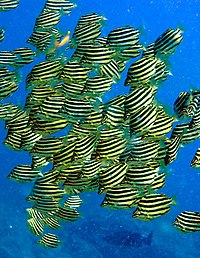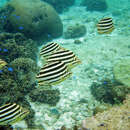Diagnostic Description
provided by Fishbase
This species is distinguished by the following set of characters: coloration - fifth body stripe inflected toward the anal fin origin at an angle of 120-150° (usually 130°); lower abdomen usually with a broken stripe, as a series of 2-5 (usually 3) spots and short dashes (Ref. 123714).
- Recorder
- Estelita Emily Capuli
Migration
provided by Fishbase
Oceanodromous. Migrating within oceans typically between spawning and different feeding areas, as tunas do. Migrations should be cyclical and predictable and cover more than 100 km.
- Recorder
- Crispina B. Binohlan
Morphology
provided by Fishbase
Dorsal spines (total): 11; Dorsal soft rays (total): 15 - 17; Analspines: 3; Analsoft rays: 13 - 15
- Recorder
- Estelita Emily Capuli
Trophic Strategy
provided by Fishbase
Occurs inshore (Ref. 75154). Found in rocky reefs (Ref. 9137) and intertidal rock pools (Ref. 124789). Feeds on plants and benthic crustaceans (Ref. 3921).
Biology
provided by Fishbase
Benthopelagic (Ref. 58302). Inhabits coastal and lagoon reefs, also in dense aggregations under ledges and in caves during the day (Ref. 9710). Also observed in rocky areas and occasionally in harbours, embankments, and coastal ports. Adults often school in large groups. It ranges between 10 and 30 m depth, but can occur as shallow as 0.3 m to as deep as 300 m (Ref. 123714). Young feeds on small crustaceans and algae (Ref. 3921).
- Recorder
- Crispina B. Binohlan
Importance
provided by Fishbase
aquarium: commercial
- Recorder
- Crispina B. Binohlan
分布
provided by The Fish Database of Taiwan
分布於太平洋區,為反赤道分布的魚種,北半球分布自中國至夏威夷群島,包括台灣、日本,南半球主要分布於澳洲。台灣分布於北部及東北部海域
利用
provided by The Fish Database of Taiwan
主要漁法為刺網及手釣,或潛水捕捉,全年皆產,但產量不大,食用經濟價值較低。顏色亮麗,可當觀賞魚。
描述
provided by The Fish Database of Taiwan
體高而側扁,呈長卵形。頭小而吻尖。眼較大。口小,前位,口裂近水平。頜齒多行,尖細,呈刷毛狀;鋤骨、腭骨均無齒。側線完全,側線鱗數56-60。背鰭硬棘X-XI,軟條數17-18;臀鰭III,軟條數14-16;尾鰭微凹。體一致為黃色,體側具5條微斜的黑色縱帶,最上方之縱帶由背鰭起點延伸至背鰭中央軟條部之後緣;最下方之縱帶由吻端貫通眼徑延伸至臀鰭起點。背、腹及臀鰭黃色;背及臀鰭上亦有黑色縱帶;胸鰭淡黃色;尾鰭淡色。
棲地
provided by The Fish Database of Taiwan
棲息於岩岸礁石區或潟湖區,亦常見於潮地內。雜食性,以海藻及底棲動物為食。
Stripey
provided by wikipedia EN

A school of
Microcanthus strigatus
The stripey (Microcanthus strigatus), also known as the footballer or convict fish, is a species of ray-finned fish, a sea chub from the subfamily Microcanthinae which is part of the family Kyphosidae. It is native to the Pacific Ocean where it has a wide range. This species may be found in the aquarium trade. It is the only known member of its genus.
Taxonomy
The stripey was first formally described as Chaetodon strigatus in 1831 by the French zoologist Georges Cuvier with the type locality given as Nagasaki.[5] It is the only species in the genus Microcanthus[6] which was named by the English zoologist William John Swainson in 1839.[2] Some authorities have suggested that there may be as many of three species within the taxon currently knows as Microcanthus strigatus but this not widely accepted.[7]
Description
The stripey has a deep, compressed body which has a rounded back, it has a distinctive pattern of oblique black and yellow, sometimes white, stripes. The stripes extend onto the dorsal and anal fins, and there is a black stripe which runs from the forehead to just to the rear of the eye.[8][9] The maximum total length is 16 centimetres (6.3 in).[3]
Distribution
The stripey is found in the Pacific Ocean where it has a disjunct distribution with a northern and a southern population. The northern population is found from Japan and Taiwan to Hawaii and the southern population is found along the east and west coasts of Australia, around Lord Howe Island and off New Caledonia.[1] The Australian distribution runs from central Queensland to southern New South Wales, although it may extend as far as eastern Victoria and the north east of Tasmania, and from Cape Leeuwin to the Exmouth Gulf in Western Australia.[8]
Habitat and biology
The stripey occurs in coastal and lagoon reefs where during the day it forms dense schools which hide under ledges and in caves. It feeds on small crustaceans and algae.[3] Juvenile stripets are often seen in tidal pools while the adults may be seen around man-made structures such as jetties and harbour walls.[8] They may enter brackish water.[7]
Aquarium
The stripey is occasionally found in the aquarium trade.[10]
References
-
^ a b Carpenter, K.E.; Robertson, R. (2019). "Microcanthus strigatus". IUCN Red List of Threatened Species. 2019: e.T68383670A68400634. doi:10.2305/IUCN.UK.2019-2.RLTS.T68383670A68400634.en. Retrieved 20 November 2021.
-
^ a b Eschmeyer, William N.; Fricke, Ron & van der Laan, Richard (eds.). "Microcanthus". Catalog of Fishes. California Academy of Sciences. Retrieved 30 April 2020.
-
^ a b c Froese, Rainer; Pauly, Daniel (eds.) (-2019). "Microcanthus strigatus" in FishBase. December -2019 version.
-
^ Eschmeyer, William N.; Fricke, Ron & van der Laan, Richard (eds.). "Genera in the family Microcanthidae". Catalog of Fishes. California Academy of Sciences. Retrieved 30 April 2020.
-
^ Eschmeyer, William N.; Fricke, Ron & van der Laan, Richard (eds.). "Chaetodon strigatus". Catalog of Fishes. California Academy of Sciences. Retrieved 30 April 2020.
-
^ Froese, Rainer and Pauly, Daniel, eds. (2019). Species of Microcathus in FishBase. December 2019 version.
-
^ a b "Stripey". Fish of the Month. Hawaiifishes.com. Retrieved 30 April 2020.
-
^ a b c Bray, D.J. (2019). "Microcanthus strigatus". Fishes of Australia. Museums Victoria. Retrieved 30 Apr 2020.
-
^ Mark McGrouther (14 January 2019). "Stripey, Microcanthus strigatus (Cuvier, 1831)". Australian Museum.
-
^ "Write-Up Wednesday: Australian Stripey (Microcanthus strigatus)". Mr Saltwatertank. 2015. Retrieved 30 April 2020.

- license
- cc-by-sa-3.0
- copyright
- Wikipedia authors and editors
Stripey: Brief Summary
provided by wikipedia EN

A school of Microcanthus strigatus
The stripey (Microcanthus strigatus), also known as the footballer or convict fish, is a species of ray-finned fish, a sea chub from the subfamily Microcanthinae which is part of the family Kyphosidae. It is native to the Pacific Ocean where it has a wide range. This species may be found in the aquarium trade. It is the only known member of its genus.
- license
- cc-by-sa-3.0
- copyright
- Wikipedia authors and editors
Habitat
provided by World Register of Marine Species
Known from seamounts and knolls
Stocks, K. 2009. Seamounts Online: an online information system for seamount biology. Version 2009-1. World Wide Web electronic publication.
- license
- cc-by-4.0
- copyright
- WoRMS Editorial Board


 A school of Microcanthus strigatus
A school of Microcanthus strigatus